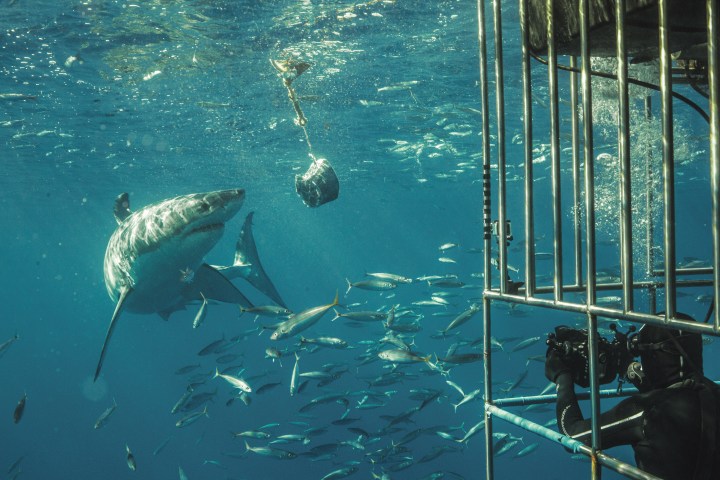TOURIST JAWCARD
White shark cage diving – plan to bring chumming closer to shore splits opinions

Great white shark populations are dwindling around Cape Town. In an effort to save the industry, the environment minister has proposed extending the operating area for False Bay’s cage diving. But surfers and other beach users don’t relish the potential risk of more sharks in the area.
Environment Minister Barbara Creecy is calling for public comment on a proposal to temporarily extend the False Bay white shark cage diving operating area, in an effort to support operators after years of dwindling great white shark sightings.
The proposal is out for public comment until 2 October. If finalised, the shark cage diving operating area in the bay would expand from its current area around Seal Island to include a section of the inshore area adjacent to Strandfontein Beach, and would permit cage diving operators to work about 1.3km to 2.5km from the shore.
The proposed extension is intended to help revive ailing ecotourism, which has been struggling since the great whites began disappearing in 2017.
“The current request for False Bay dates as far back as 2014. However, because of the risk associated with bathers and prevalence and sightings of white sharks in the bay at that time, the department did not see the possibility of considering the request,” Department of Forestry, Fisheries and the Environment spokesperson Albi Modise told DM168.
The department “remains mindful of the history of a shark attack that occurred in the area, as well as the public’s concerns and perceptions associated with chumming”.
DM168 understands the proposal has been backed by cage diving companies in the bay, which have been calling for an area extension for years. The extension would allow operators to attract other shark species, including the bronze whaler and the sevengill cow shark.
“False Bay is the only area of the three shark cage diving operations that hasn’t got an inshore operating area, because even when the white sharks were here, our business was always curtailed to white shark patterns and could not interact with the bronze whalers,” explained founder and director of African Shark Eco-Charters Rob Lawrence, who added that extensions have been allocated to Gansbaai and Mossel Bay.
Read more in Daily Maverick: “Where have all the Great White Sharks gone?”
In pre-pandemic days, and before the disappearance of white sharks from the bay, shark cage diving was booming.
After Boulders Beach, shark tourism in False Bay was the largest marine tourism venture in the southern peninsula, co-founder of Apex Shark Expeditions Chris Fallows told DM168. “It attracted more than 7,000 people to Simon’s Town each year,” he said.
Fallows described the industry as “the lifeblood of Simon’s Town”, which kept hotels, B&Bs and restaurants alive during the doldrums of winter.
But without an extension, the sector faces an uncertain future. “If we are unsuccessful at being able to work in that slightly extended area, all companies would close down,” co-owner of Shark Explorers Stephan Swanson said.
Lawrence, who has been operating in the area since 1995, said: “Seal Island was arguably the premier white shark viewing and diving spot in the world until about 2017/18. [The absence of great whites], coupled with two years of Covid-19, has all but decimated the industry.”
Goodbye, great whites
On average, 205 great white shark sightings were recorded a year from 2010 to 2016 in False Bay. But since 2017, white sharks have all but disappeared from the area. In 2018, there were 50 sightings. In 2021, Shark Spotters, a shark safety and research organisation, reported only four.
Read more in Daily Maverick: “Cape Town woman killed in Sunday morning Plettenberg Bay shark attack”
In 2016, the results of a seven-year research study by marine biologist and lecturer at Stellenbosch University, Dr Sara Andreotti, and her co-authors revealed that the great white shark population was in peril, with only 353 to 522 roaming South Africa’s coastline.
Speaking to DM168, Andreotti said the research, based on a combination of genetic and photographic identification results, showed that the white shark population had been declining for years because of “overfishing of white sharks’ food resources, climate change, by-catch of white sharks by commercial fisheries, poaching and KwaZulu-Natal’s shark nets, which are still operating on 37 beaches”.
Andreotti explained that the evidence of the now famous pod of orcas hunting white sharks in 2017 isn’t the main or only cause of shark decline, but rather “the straw that broke the camel’s back”.
Read more in Daily Maverick: “As Great Whites disappear off the Cape’s Seal Island, sevengill sharks, ‘living fossils’, move in”
In May 2020, following public concern about shark populations and the ensuing conflict between fishers and ecotourism operators, Creecy set up a panel to review the country’s national plan of action for the conservation and management of sharks.

A great white takes bait as tourists watch from the safety of a steel cage at Gansbaai. (Photo: EPA / Nic Bothma)
Contrary to Andreotti’s findings, the panel found no evidence that fishing was to blame. “The panel noted with concern the disappearance of the white sharks from ecotourism hotspots, but concluded that these were more likely a shift in distribution from west to east as a result of recent orca occurrence and predation,” Modise told DM168.
Modise said the panel found “no convincing connection” between the disappearance of white sharks from False Bay and Gansbaai and the demersal shark longline fishery.
Read more in Daily Maverick: “Why SA’s great white sharks are disappearing”
But research published in April, which examined the overlap of white sharks’ movement with fishing vessels, found that the demersal shark longline fishery “had the highest relative spatial and temporal overlap, followed by the pelagic longline fishery and the KwaZulu-Natal shark nets and drumlines”. The findings showed that the shark nets and drumlines posed “the largest relative risk” to white sharks out of the fisheries assessed in the study.
Attracting other species
When the great whites vanished, cage diving operators in False Bay were in a quandary.
“We needed to restructure our business and start working with other species of sharks,” said Fallows.
Fallows explained that the proposed extended operating area has “significant numbers” of these shark species at certain times of the year and, with roughly a 600m to 800m extension, cage divers “could run a far more successful tourism operation”.
Read more in Daily Maverick: “Quest for elusive white shark decades ago raises questions about the species today”
In response to questions from DM168, the City of Cape Town’s deputy mayor and mayoral committee member for spatial planning and environment Eddie Andrews said the City does “not object to the consideration of extending the current operating area”. But he said that “public perception and our complex South African history” must be considered in the decision-making process.
“We… recognise that the Strandfontein coastline forms part of the previously disadvantaged communities of Cape Town and the perception may be created that cage diving is allowed off previously disadvantaged communities’ beaches but not off previously (and currently) advantaged communities’ beaches,” Andrews said.
Visit Daily Maverick’s home page for more news, analysis and investigations
While there may be public concern about operating with chum nearer to the shore, cage diving operators say this would not affect bathers or surfers in the area.
Shark Spotters project manager Sarah Waries told DM168 that while there are a lot of misconceptions around shark cage diving and chumming, “there’s no evidence to suggest that there is any link between shark cage diving and shark bites”.
Moreover, there have been pioneering studies done in South Africa which have found the effects of cage diving on the behaviour of some sharks to be minor, with the majority of sharks observed showing little interest in the chum.
DM168 spoke to one commercial linefisher in False Bay, who asked to remain anonymous, who believed that the extension would have minimal impact on his fishing operations: “I don’t foresee an extension of the cage diving area being an issue for us.”
Too close for comfort
But DM168 understands there is considerable concern, among some local surfers who use Strandfontein Beach, over the proposed area extension allowing cage divers to attract sharks further inshore.
Local surfer Rezar de Nicker, who grew up surfing in Muizenberg, said there are many people in False Bay, including surfers, swimmers and fishers, who use the beach for recreational purposes, and the proposal is “completely wrong”.
“The main concern is putting lives at risk,” said De Nicker, adding that cage diving in the inshore area could also cause blood and chum to wash up on the beach.
Nigel Savel, founder of the 9Miles Project, a non-profit organisation in Strandfontein that works with young people in coastal communities and uses surfing as a catalyst for upliftment, said the proposed extension is a “big concern”. To allow cage divers to operate further inshore comes at “massive risk to a recreational community that utilises the ocean so frequently”.
Savel said that having cage diving operators closer inshore would mean they would need to be “constantly vigilant” while running their programmes.
“These guys are doing it for profit, but you cannot put a price on a life,” he said.
Using marine resources sustainably
Andreotti believed the proposal was a step in the right direction towards creating “a non-consumptive way of using our marine resources”.
Fallows concurred: “If the government is serious about creating job opportunities and creating sustainable utilisation of resources in a non-consumptive way, this is the perfect opportunity to do that.”
While the white shark is the most protected shark in South Africa in terms of legislation, routine enforcement of the law is required to protect the environment and reduce poaching, added Andreotti.
“My biggest frustration is seeing the number, ringing the alarm bell, and feeling like it didn’t help,” she said.
In the proposal, Creecy stressed that the area extension was temporary: “If great white sharks return to the bay… the new area will be closed.”
DM168 asked Andreotti about the likelihood of this occurring.
“It’s very, very tiny. I would be the happiest person in the world if I were wrong about this,” she said. DM168
This story first appeared in our weekly Daily Maverick 168 newspaper, which is available countrywide for R25.




















 Become an Insider
Become an Insider
At peak, 7000 tourists a year or 20 a day and an average of 205 sightings a year – must be pretty disappointing for many. How many tourists surf at Muizenberg on a daily basis? its multiples of 20. If you add thye locals who support the surf shops, coffee shops, restaurant’s and car guards, you are adding zero’s. The surf industry in Muizenberg probably employs 60-100 people on a continuous basis, mostly young people, again multiples of the jobs created by extending shark cage zones. “The majority of sharks show little interest in chum” – sorry, red herring, then why propose using chum? What’s the fine for feeding a wild baboon ? Why, because it leads to behavioral change. An ocean eco tourist learns the skill, puts on their dive gear and observes what comes there way. There are numerous dive operators who can provide tourists with amazing experiences without having to resort to chumming and cages. The motives of people wanting to sit in a cage and dangle food to attract a predator for that Instagram shot is, in my opinion, pretty pathetic. My opinion, cage diving is like canned animal hunting, its not eco tourism, its ego tourism. There is no definitive evidence that sharks will not be attracted or change behaviour, so why risk an existing and functional healthy recreational and business eco system (that does not burn litres of diesel) for a small minority of operators?
What about Muizenberg’s Surf Tourism Industry?! Muizenberg is a flourishing area now and this could risk everything that has been built in the past few years.
And allowing this does nothing to address the cause of the decline in our white shark populations; “overfishing of white sharks’ food resources, climate change, by-catch of white sharks by commercial fisheries, poaching and KwaZulu-Natal’s shark nets, which are still operating on 37 beaches”. Why not start with the cause instead of reacting to the problem?